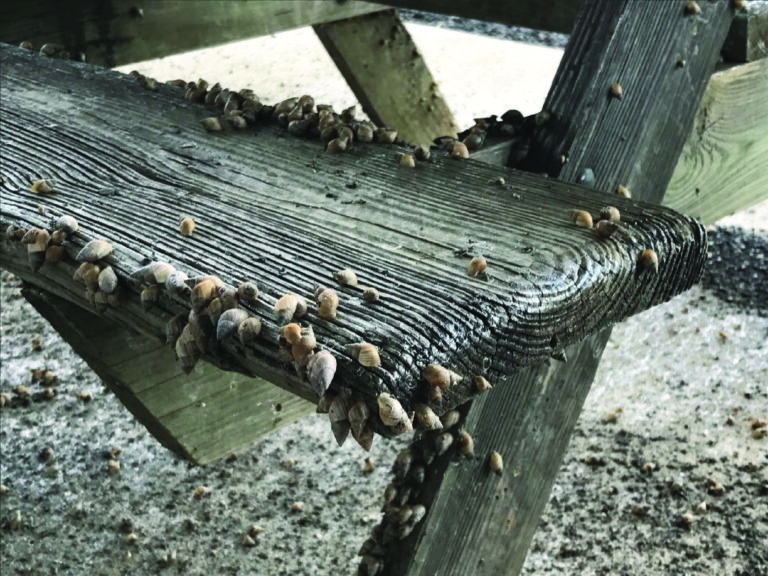Legacy Post Disclaimer
This is a #Legacy post imported from The Apalachicola Time’s previous platform. If you’re experiencing issues with this article, please email us at news@nevespublishing.com.
Shrimp boats is a comin to St. George Island
“The shrimp boats is a comin’,” as Jo Stafford enchantingly sang in her 1951 pop tune, and it’s hard to believe that it took this long for Franklin Countians to give the lowly water-bug his due. But thanks to the St. George Lighthouse Association, the little guy will finally share in the Apalachicola Bay oyster’s celebrity status in the first SGI Shrimp Fest coming up this Saturday, May 14.
The one-day event, a fundraiser for the lighthouse association, will feature musical entertainment, games for the kids, and of course all manner of local shrimp dishes sure to please. Hot Mess, Apalachicola’s home-grown five-piece Zydeco Swamp Pop band will take the stage at 11 a.m, joined by special guest John “JB” Babich. Headlining at 3:15 p.m. will be singer/songwriter/slide-guitarist Bill Wharton, a.k.a. “The Sauce Boss.” The Boss’ “swampy Florida blues-rock” is reportedly every bit as good as his shrimp gumbo – which he’ll prep on-stage and serve up for folks in the audience to sample after the show.
It truly is about time these critters – we call a group of them a “troupe” or a “colony” – get their own celebration! After all, Amelia Island has hosted an annual ShrimpFest for nearly 60 years, the U.S. has a National Shrimp Day every May 10 (not to mention National Shrimp Scampi Day on April 29), and folks have been simply crazy about these savory arthropods for millennia.
Scientists have discovered fossilized shrimp from the Jurassic Period in Oklahoma dating back more than 300 million years, and humans have been dining on these decapods (from Greek for “10-footed”) for at least a 100,000 years. Along with fish and oysters, shrimp were an essential part of the ancient Mediterranean diet, fishing was a major industry (small shrimp were used as bait), and the Romans even had an annual seafood festival, the Ludi Piscatorii or “Fishermen’s Games,” held June 7 on the banks of the Tiber River.
Aristotle called shrimp “hunchbacks” for their distinctive arched shape. A later writer mentioned one species as large as lobster, and the 2nd cent. A.D. satirist Juvenal describes a banquet at which the host is served an asparagus-garnished prawn or “jumbo shrimp” (a favorite oxymoron) that filled the entire platter. Fried or roasted were preferred to boiled; some recipes called for serving shrimp on fig leaves or with a honey glaze. The fact that many varieties turn a dark pink when cooked led to the ancient quip “redder than a roasted shrimp.”
The 5th-century Roman cookbook attributed to Apicius contains recipes for peppery shrimp-cakes and a sauce made with vinegar, celery seeds, and boiled egg yolks for slathering on lobster and shrimp (which the Romans called squilla or cammarus, modern Spanish el camarón). Eel and lamprey were served topped with a shrimp sauce. The CRUSTy CRUSTaceans (both words come from Latin crusta, meaning a hard casing or shell) were so valued that they were beautifully depicted along with other sea creatures in Roman art such as mosaics and gemstone engravings.
A $50-billion industry worldwide, shrimping off the southeast U.S. coast has been dated as far back as A.D. 600. Most of our homegrown shrimp now come from the Gulf of Mexico and a recent report showed shrimp as the #1 income-producing seafood species for the state of Florida, generating over $50 million a year. Over a million pounds, 20 percent of the state’s catch, come from our Apalachicola Bay, which is habitat to white, pink, and brown varieties.
Our word “shrimp,” by the way, derives from an Old Nordic word originally meaning “a thin person.” So if you call someone who is slight of frame a “shrimp,” an English usage dating to the 14th century, you’re being awfully mean, but linguistically accurate.
Even meaner are those folks who insult the poor shrimp themselves by calling them “cockroaches of the sea.” With their segmented bodies and exoskeletons, roaches and shrimp do belong to the same animal phylum, Arthropoda, and both, it’s true, are omnivores that scavenge waste.
But as Bubba Blue told his buddy Forrest one day during basic training (in the 1994 film “Forrest Gump”), “shrimp is the fruit of the sea. You can barbecue it, boil it, broil it, bake it, sauté it. Dey’s uh, shrimp-kabobs, shrimp creole, shrimp gumbo. Pan fried, deep fried, stir-fried.” Well, Bubba’s list of dishes goes on (search YouTube for “Bubba on shrimp”), and I’m hoping to find a whole mess of’em over on the island come May 14.
Rick LaFleur is retired from 40 years of teaching Latin and Classics at the University of Georgia; his latest books are The Secret Lives of Words, a collection of his widely distributed newspaper columns, and Ubi Fera Sunt, a lively translation into classical Latin of Maurice Sendak’s Where the Wild Things Are. He and wife Alice live part of the year in Apalachicola, under the careful watch of their French bulldog Ipsa.



Meet the Editor
David Adlerstein, The Apalachicola Times’ digital editor, started with the news outlet in January 2002 as a reporter.
Prior to then, David Adlerstein began as a newspaperman with a small Boston weekly, after graduating magna cum laude from Brandeis University in Waltham, Massachusetts. He later edited the weekly Bellville Times, and as business reporter for the daily Marion Star, both not far from his hometown of Columbus, Ohio.
In 1995, he moved to South Florida, and worked as a business reporter and editor of Medical Business newspaper. In Jan. 2002, he began with the Apalachicola Times, first as reporter and later as editor, and in Oct. 2020, also began editing the Port St. Joe Star.